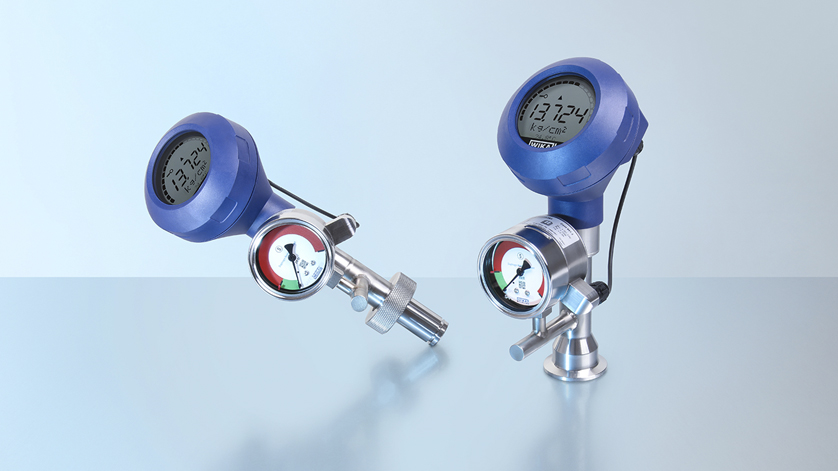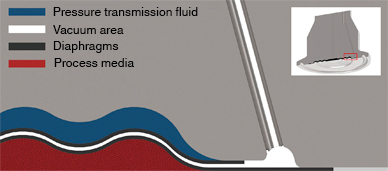
A diaphragm seal system with diaphragm monitoring from WIKA meets the highest safety requirements in sanitary applications. The model DMSU21SA with process transmitter and HART® protocol (cover picture) can also be integrated into digitalised environments.
Why did WIKA develop the patented system for diaphragm monitoring? Because diaphragm seals are basically robust and they therefore enable, in particular, the connection of electronic pressure measuring instruments to critical processes. Versions with flush diaphragms can also be cleaned without leaving residues, a must in pharmaceutical processes or aseptic food production.
Aggressive process conditions can damage the diaphragm in the long term
In the case of persistently harsh process conditions, damage to diaphragms which are generally resistant cannot be completely ruled out. Aggressive cleaning agents, for example, can cause long-term corrosion. In extreme cases, this can lead to cracks or perforations in the sensitive pressure element. The liquid for pressure transmission will escape via these damaged points and contaminate the product. Such an incident is usually only noticed too late, for example, at the end of a batch. As a result, the economic losses can be considerable.
Diaphragm seal system with two diaphragms in series

Cross-section through the lower body of a diaphragm seal with diaphragm monitoring. In the right half of the picture, the connecting channel to the diaphragm seal as a monitoring instrument can be seen.
A diaphragm seal system for diaphragm monitoring from WIKA prevents such damage. It works with two diaphragms in series. The space between them is evacuated and a pressure switch monitors the vacuum.
If there is a diaphragm rupture on the process side, the vacuum is broken. The monitoring instrument reacts to the pressure change and immediately initiates a damage alarm. Meanwhile, the second diaphragm safely seals off the process. It thus enables continued pressure measurement until the damage is repaired.
Previous diaphragm monitoring systems have operated with two separate output signals corresponding to the integrated measuring instruments for process pressure and vacuum monitoring. Consequently, they required two cable connections to the control room or process control.
Diaphragm monitoring coupled to the logic of the process transmitter
On the other hand, the model DMSU21SA, designed for digitalised infrastructures with process transmitters and HART® protocol, only outputs one signal. This is because the logic of the transmitter also processes the pressure value of the pressure switch installed for diaphragm monitoring. The transmitter transmits the other information on process pressure, temperature and status as standard anyway. Data transmission is based on a 4 … 20 mA signal. The indication of any damage to the diaphragm can therefore happen via HART® as well as via a residual current. The latter variant also enables the DMSU21SA to be installed in an existing plant (“brownfield”).
Simple commissioning using the plug-and-play principle
The advantages of the “digital” diaphragm seal system with diaphragm monitoring also include easy commissioning using the plug-and-play principle. Existing measuring instruments can therefore be exchanged for the DMSU21SA without additional effort. Furthermore, the system is evaluated as a whole due to its functional concept. For use in sanitary applications, it has EHEDG (EL Class I) and IECex approvals and is 3-A marked.
Note
Further information on the model DMSU21SA and other diaphragm monitoring systems can be found on the WIKA website. Details on risk minimisation through self-monitoring pressure displays can be found in our flyer. If you have any questions, your contact will gladly help you.
Also read our articles
How do diaphragm seals work?
Diaphragm seals for stable flow measurement in deep seas
Find out more about the diaphragm monitoring system and the function of a diaphragm seal in the following videos:

